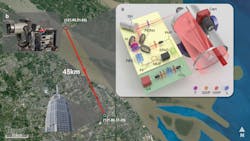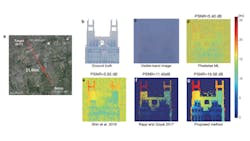Single-photon LiDAR research accomplishes 3D imaging at extreme distances
Researchers from the University of Science and Technology of China in Shanghai have demonstrated the ability to take photographs of subjects up to 45 km (28 miles) away by using single-photon LiDAR. When coupled with a computational imaging algorithm, the new system can take high-resolution images at tremendous distances, potentially at hundreds of kilometers away.
Single-photon LiDAR (SPL) operates by acquiring one photon per ranging measurement instead of hundreds or thousands of photons, which gives SPL increased efficiency. Use of 532 nm (green) lasers allows SPL systems to penetrate semi-porous elements like vegetation, ground fog, and thin clouds, and enables superior water depth measurements compared to traditional methods.
These advantages make SPL technology attractive for large-area applications like geospatial mapping. The intensity of data gathered by SPL can lead to increased high and low noise points that must be filtered to provide accurate imaging, however.
The researchers from the University of Science and Technology of China achieved their results by designing a high-efficiency coaxial-scanning system that is better able to collect the weaker photons returned from longer-distance ranging measurements, and a computational algorithm designed specifically for long-range 3D imaging to filter out background noise.
The scanning system was built from a Cassegrain telescope with 280 mm aperture and high-precision two-axis automatic rotating stage, assembled on a custom-built aluminum platform. A 1550 nm laser with 500 ps pulse width at 100 kHz repetition rate, and average power use of 120 mW, was used for ranging. The laser output was polarized vertically, projected into the telescope via a small hole in the mirror, and expanded.
An InGaAs/InP single-photon avalanche diode detector registered the returning photons after they were spectrally filtered, and the custom-designed algorithm used global-gating and a 3D matrix to provide super-resolved image reconstructions.
The researchers placed their imaging equipment on the 20th floor of a building and targeted the Pudong Civil Aviation building at a distance of 45 km. The experiment was conducted at night, and a 128 x 128 image was produced. A second experiment targeted a skyscraper named K11, that was 21.6 km away, to produce a 256 x 256 image. This experiment was conducted at day and night. In all cases, the custom algorithm was able to detect features of the buildings that other, established algorithms could not.
The researchers concluded that their system could be adapted for rapid data acquisition of moving targets and fast imaging from moving platforms, and that refinements of their system could make image acquisition of objects a few hundred kilometers away feasible.
Related stories:
Hyperspectral camera set to monitor climate change from space
PRISMA Earth observation satellite carries custom-built hyperspectral instrument
Share your vision-related news by contacting Dennis Scimeca, Associate Editor, Vision Systems Design
SUBSCRIBE TO OUR NEWSLETTERS
About the Author

Dennis Scimeca
Dennis Scimeca is a veteran technology journalist with expertise in interactive entertainment and virtual reality. At Vision Systems Design, Dennis covered machine vision and image processing with an eye toward leading-edge technologies and practical applications for making a better world. Currently, he is the senior editor for technology at IndustryWeek, a partner publication to Vision Systems Design.

